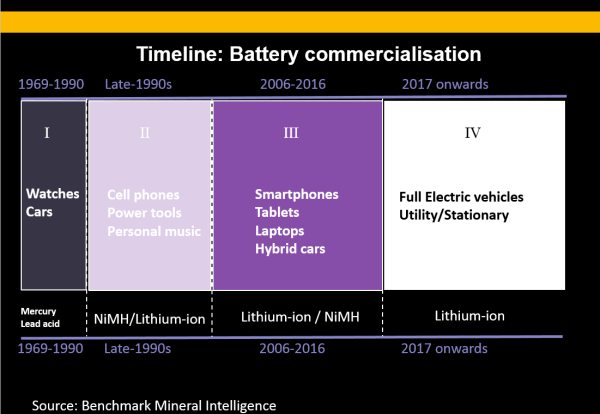
Image from Benchmark Mineral Intelligence
For a product that is so well known and commonplace in today’s world, it can be a surprising fact to some that batteries are still a young and, so far, neglected industry.
After seeing portable technology take-off in the last decade with the boom in the adoption of smartphones and tablet computers, the batteries that power these devices have largely been overlooked. The research and development focus on power storage has been significantly less than the technology being powered.
Benchmark Mineral Intelligence has identified four distinct phases of market commercialization for batteries which shows how this could be about to change.
Phase 1: 1969 to early-1990s
The first-true commercialized battery was introduced with the advent of the quartz watch in the late 1960s, a revolutionary design which saw a mercury battery power a quartz crystal resonator. In the same era, lead acid batteries in cars were also taking off.
Phase 2: Late 1990s to 2006
It took another two decades before a second generation of markets developed with power tools, mobile phones, and personal music players (Sony Walkman) in the mid-to-late 1990s. This sparked the rise of the rechargeable battery where lithium-ion and nickel metal hydride chemistries were competing.
Phase 3: 2006-2016
We, in Benchmark’s opinion, are in a third phase of battery commercialization which has seen mass market, global adoption of battery powered technologies. This has been driven by smartphones, tablets, laptops and hybrid vehicles.
It has also seen lithium-ion overtake nickel metal hydride as the favoured battery chemistry.
Phase 4: 2017 onwards
By 2017, Benchmark expects to see a fourth phase of battery commercialization emerge. As the sector gears up for significant new battery supply from megafactories in the US and China, in addition to new supply from Japanese are South Korean manufacturers, new lower cost output of lithium-ion cells will hit the market.
This will likely see increased uptake from electric vehicles and off-grid stationary (utility) storage which will use significantly larger batteries than those in Phases 1-3.
Image of Aztec calendar by Mike McCarty